How does a group of high school students conduct a biology experiment on the International Space Station? Ask Dan Saldana.
Today a retired aerospace engineer and a mentor for students, in the late 1940s Saldana was a fifth grader in Monterey, California whose life was about to take an unexpected turn. He had just lost his father, who only a few weeks earlier had succumbed to lead poisoning from years spent working on ships for the war effort. Saldana estimates that about 40% of students in his fifth grade class had no fathers due to World War II. Those losses form the backdrop for his memory of their teacher coming into class one day exclaiming “We won! We won!”
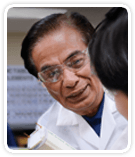
International Space Station Project Leader
Applied Math, Science, and Engineering Institute
Valley Christian High School of San Jose, California
What they had won was a trip across town where, Saldana remembers, “we spent several weeks listening to this guy talk about space. He had these little models and wanted to go to the moon real bad.” That “guy” turned out to be Dr. Werhner von Braun, the German scientist who would become one of the key figures in America’s space program. When Saldana met him, von Braun wasn’t yet regarded as the greatest rocket scientist of all time; he was teaching at the Naval Postgraduate School and talking to Saldana’s fifth grade class about space.
“To me, that was a God thing,” Saldana reflects. “Why else would they pick our fifth grade class to go hear a guy like Dr. von Braun? And who at his level would go and talk to a bunch of little fifth graders? Why? That’s why I’m here today.”
Flash forward about 50 years. After earning degrees under the shadow of the first Sputnik, then, degree in hand, choosing Lockheed as his employer, Saldana’s career as an engineer roughly tracked America’s space program. He had a hand in projects ranging from the first generation of spy satellites to the first space shuttle payload to the Hubble Space Telescope, followed by a second career working at NASA Ames Research Center and teaching satellite design engineering at Stanford University.
Today, Saldana’s life story has come full circle, as he helps students learn about — and work in — space, just as years ago von Braun helped him. Saldana has come out of retirement to help build what amounts to an educational space program at Valley Christian High School as part of that school’s Applied Math, Science, and Engineering (AMSE) Institute.
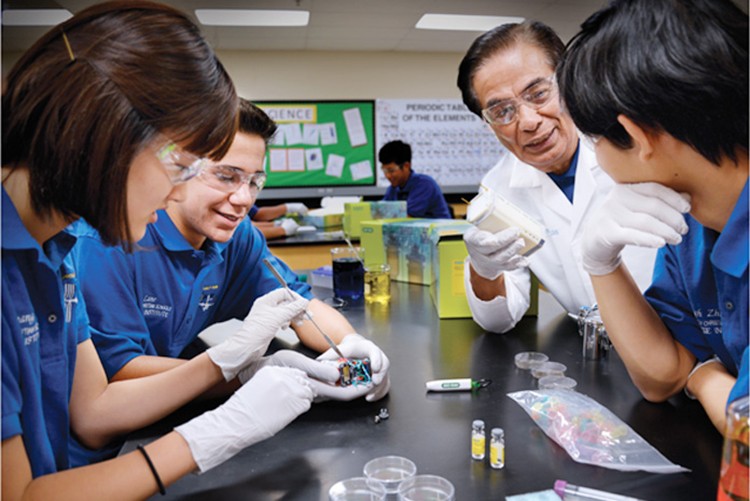
Dan Saldana and students working on a Nanolab module to contain bacteria from a Bio-Rad pGLO kit. The students designed a self-contained experiment to add broth to lyophilized bacteria, then illuminate and photograph the bacterial colonies at intervals. Every few days, one of the astronauts aboard the ISS would download and transmit the data from the Nanolab.
“The school expects excellence in everything,” Saldana said, “When we formed the AMSE board, our goal was to be number one in science. We didn’t do it a step at a time, though. We wanted to make a quantum leap. I said, ‘How about we put an experiment into space?’” The way Valley Christian’s crash program came about points to how much has changed in human utilization of space since the days of von Braun’s models and dreams.
Valley Christian’s International Space Station (ISS) program, begun in 2009, launched its first experiment — testing plant growth in microgravity — in 2010. Valley Christian’s space station opportunity was made available by NanoRacks, LLC via its Space Act Agreement with NASA’s U.S. National Laboratory. NanoRacks, a private company, puts payloads onto the ISS by encouraging users to think small. Since every pound that goes into orbit is extremely dear, building a very small experiment allows a school to minimize costs while giving its students a significant engineering challenge. The experiments go into orbit onboard the unmanned cargo missions that regularly resupply the ISS. For example, the most recent round of experiments, which went into space in early 2013, flew aboard a Dragon capsule operated by the private company SpaceX. The astronauts who receive the experiments simply plug them in using USB connectors and then download data onto their laptops every few days. The experiments return to Earth with the astronauts in their Soyuz capsule.
Standardization of space cargo through NanoRacks’ modules, private companies supplying the ISS, the “plug and play” design of both the experiments and the ISS itself, and the international character of today’s human presence in space — all these developments, encountered by the students’ experiment on its way into orbit, reveal how far we’ve come since a fifth-grade Dan Saldana heard about space from Werhner von Braun.
Valley Christian’s first experiment proved the concept, and the next year the students sent several experiments, now in a more miniaturized format. This new, even smaller container made the experiments both more economical and more standardized, allowing several more schools, along with groups such as the Girl Scouts of Hawaii, to join VCHS in bundling experiments. By the third round of labs, which went into space in early 2013, Saldana’s students wanted to explore bacterial growth. Would bacteria grow in a microgravity environment better or worse than they do on Earth? And how could the students observe the growth that was occurring?
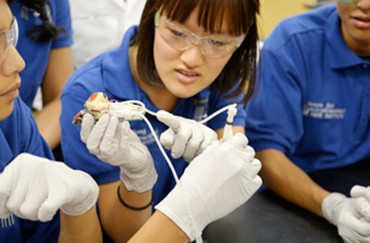
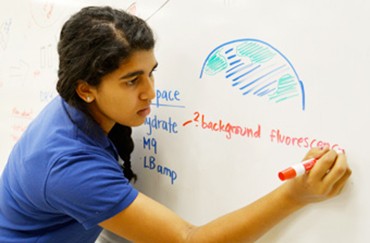
Left: students discuss the apparatus for creating a viable environment for bacteria in microgravity. The behavior of liquids such as the broth for the bacterial growth is entirely different in near-weightlessness, and poses significant design challenges. Right: students were able to incorporate green fluorescent protein into the bacteria in their experiment using Bio-Rad’s pGLO™ bacterial transformation kit.
In searching for an organism that would work within the small confines of their high-flying Nanolab, Saldana’s students came across Bio-Rad’s pGLO™ Bacterial Transformation kit. This Biotechnology Explorer™ lab gives students the tools to create E. coli bacteria that carry a bioluminescent jellyfish gene that causes the bacteria to express green fluorescent proteins (GFPs). Students transform the bacteria using the same techniques biotechnologists employ to create “designer” proteins for cutting-edge therapies and other applications. The result is a bacterial culture that glows green under UV light, a good fit for the Valley Christian students’ ISS lab apparatus, which illuminated the culture using UV LEDs and took a digital picture periodically.
“You have to meet tough requirements from NASA to go into space. You get a long list, everything from having three levels of liquid containment to prevent leaks, to what kind of plastics you can use,” Saldana says. “For sending up E. coli bacteria, by going to Bio-Rad we were able to show NASA we were using good quality materials from a reputable provider. We’ve been very impressed working with Bio-Rad in setting up these experiments.”
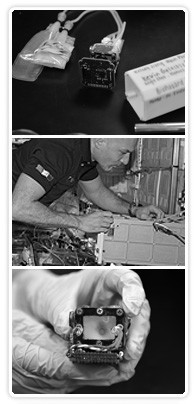
The experimental apparatus ready to load into the Nanolab housing; an astronaut plugs a module (actual NanoRacks module not pictured) into the wall of the ISS; the growth chamber after returning to Earth. In 2014, five experiments from Valley Christian High School, including another bacterial growth experiment using the pGLO kit, two experiments from Valley Christian Junior High, and experiments from 13 partner schools from Hawaii to Finland are scheduled to launch to the ISS aboard an Orbital Sciences Cygnus spacecraft. Valley Christian High School’s Quest-1 microsatellite is scheduled to travel aboard the same flight.
As much as meeting NASA’s requirements, the bacteria had to work with a range of high school students — everyone from freshmen to seniors — some of whom had limited biology experience. Current ISS project team member Cooper Ge says, “Bio-Rad has been a tremendous help in getting us the E. coli to work with. The kits are pretty easy to use too.”
Along with the limited physical space for the experiment, the constraints of the launch schedule created further engineering challenges for the AMSE team. Before blasting off on the SpaceX supply flight, the experiment had to sit for at least six weeks, with the possibility of delays due to launch conditions or technical factors. To overcome this hurdle, students used lyophilized bacteria and designed a system of bags to pump nutrients to the dried bacteria once the apparatus had attained orbit.
These constraints imposed another challenge on the team. Because of the small space their payload allowed, they needed a nutrient-rich broth to feed the microbial colony. However, the richer the broth, the more opaque it became, and thus the harder it would be to spot the glowing GFPs in the transformed bacteria. “We struggled with getting the right broth,” says Monica Bodd, a leader from last year’s ISS biology experiment team. “Thanks to Bio-Rad, we got a number of different recipes, but it took a lot of testing. I remember we spent a lot of time in the lab, hiding under a desk in the dark trying to see the bacteria when the broth was too dark. But we eventually found the right one.”
Such trial and error allowed students to perfect their apparatus, learn from any unexpected results, and iterate their designs for the next launch. “[The students] have a great opportunity here to succeed. But better yet, they can fail,” says Saldana. “Because very few times in your life do you have an opportunity to fail and learn something from it.”
For this coming year, the AMSE students plan an even more ambitious experiment than last year’s using the pGLO bacteria kit. This time, they want to observe not only how the bacteria grow in microgravity, but how they die. To this end, they have created a multichamber design that includes the bacteria in powder form, the life-supporting broth to be added once in orbit, and an antibiotic and a bacteriophage to kill the E. coli. By comparing the results to a control apparatus on Earth, the students hope to draw conclusions that could prove valuable as astronauts perform longer and longer space flights, perhaps having to treat an illness on the way to Mars.
“If we want to expand space travel, we want to know if we get sick how to treat it,” says Andrew Rao, another student on the ISS team. “This experiment will help us find out a little bit about how these microorganisms function in this different environment.” “Our hypothesis at this point is that the phage will work faster than the antibiotic in killing the bacteria, because that’s also the way it works on Earth,” says Kian Lane. “But you never know what’s going to happen because in past experiments things have happened that you didn’t expect.”
The results of the experiment could have implications for treating infections on Earth as well. Rao explains, “If we see that the antibiotic or bacteriophage works better at killing the bacteria in space, then we can look further into why it works better, and perhaps replicate that back on Earth to improve our medicine.”
As with the first space missions, necessity and the mission constraints have led to innovations by the AMSE team. Saldana says, “We came up with something very unique. We found out there’s a Japanese company trying to do a similar thing, and that is to get a syringe and put a motor on it so that it can inject the antibiotic into the growth chamber, and make it all small enough to fit in the Nanolab.”
Beyond their technical achievements, Saldana sees the students growing and maturing as people as they confront the challenges of doing biology in space. “How do you lead a team? How do you work in a team?” he says. “At their age, wherever they look it’s ‘Me! Me! Me!’ We want, ‘We! We! We!’ So the loudest voice isn’t always the one that wins. They learn these skills and they get their experiments to space and back in nine months. They solve problems that their parents don’t know about, their teachers don’t know about.”
Saldana is proud that his students have risen to the challenge of working in space, in some cases solving graduate-level problems to design experiments. He’s also pleased that, because of their work, their Nanolab design offers other schools and groups an economical way to get experiments into space, and that each year more experiments go up into space. And Saldana’s looking forward to his team’s next endeavor: launching, tracking, and commanding a microsatellite named Quest-1. “Never underestimate a high school — or even a junior high — student,” Saldana says. “I’m really proud of what they’re doing. They have a very bright future.”
The students’ biology experiment to investigate the life and death in microgravity of bacteria transformed with the pGLO kit is scheduled to launch to the ISS aboard Orbital Sciences’ Cygnus spacecraft on May 8, 2014 and return approximately six weeks later.

